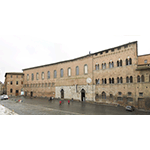Complesso Museale di Santa Maria della Scala [Santa Maria della Scala Museum Complex]
The very ancient hospital, founded by the Cathedral Canons to shelter pilgrims, assist the poor and take in abandoned children, was mentioned already in a document from 1090. It was called "della Scala" because of its position, directly facing the stairs leading up to the Cathedral’s entrance. The hospital’s relief activities and its daily life are admirably illustrated in the so-called "Pilgrimage" cycle of frescoes painted between 1441 and 1444 by Domenico di Bartolo, Lorenzo Vecchietta, Priamo della Quercia (brother of Jacopo) and Pietro di Giovanni d'Ambrosio, commissioned by the Rector of the Hospital Giovanni Buzzichelli. The architectural style of the Pilgrimage, a great structure where pilgrims were accommodated, is clearly derived from France, bearing witness to the continuous contacts between Siena and Europe made possible by the Via Francigena. This enormous thoroughfare, which is still visible and can still be traversed in part, connected Italy to Northern Europe, and was travelled each year by thousands of pilgrims journeying to the great sanctuaries (St. Peter’s, St. James of Compostella, and Montauban). For this reason it was highly important for the founding and development of the numerous hospitals that, from the 11th century on, replaced the so-called "Xenodochi" (from the Greek xenos = foreigner, and dokeion = hostel). Travellers in the Middle Ages, often preyed on by bandits and exposed to the continuous danger of contracting contagious diseases, found in these hospitals not only a bed for the night but also nurses, stables for their horses and warehouses in which to deposit their goods.
The Hospital of Santa Maria della Scala, thanks to generous alms and to the legacies of pilgrims, soon became autonomous enough on the economic level to allow the development of an organisation independent of religious power, regulated by an innovative statute dating from the early 14th century. Its management became progressively more secular up to 1404, the year in which the Commune claimed for itself the right to elect the Rector, the institution's highest authority. Moreover, the enormous farmlands owned by the Hospital, the "granges", provided a source of subsistence for the city in times of famine or epidemic.
In 1411 a pharmacy was established, and in the 16th century it was enriched by an important group of ceramics, mainly of local production. In 1518 it possessed around 1,800 vases, only scarce testimony of which remains on display in the hospital today. In 1588 a "Giardino dei Semplici", or medicinal herb garden, was annexed to the hospital.
Always active over the centuries, the hospital employed an anatomical dissector (1743), masters of surgery, masters of childbirth and of anatomy (1759). It also formulated rules for the training of practising doctors and student interns, arranged for consulting university professors in difficult cases, improved assistance to the mentally ill and to women giving birth. In 1778 the university and the hospital shared on an equal basis the costs of improving the equipment of the anatomical cabinet. In the 18th century the work of Paolo Mascagni, professor of anatomy at the university, was outstanding. In the early years of the 19th century it became compulsory for newly graduated students to spend a period of practical training at the hospital, consisting of two years for physicians and five years for surgeons.
Today the ancient Hospital of Santa Maria della Scala is a large and fascinating museum complex possessing important Sienese collections on the history of art and the history of medicine.
****************************
Texts by Antonella Gozzoli
English translation by Catherine Frost
Last update 19/gen/2008




